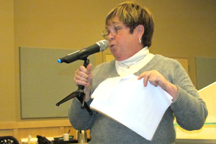
Joanne Morris of Oroville addresses the crowd at the Okanogan County Public Utilities District’s information meeting on Tuesday, April 19. She said the straw that broke the camel’s back for her in regards to the PUD’s rates was when she realized she
OKANOGAN – Concerns from Okanogan County Public Utility District customers were heard during a PUD information meeting on Tuesday, April 19 before frequent questions were answered during a prepared presentation.
The meeting was opened by PUD Board President Ernie Bolz who told the assembled crowd that informational meetings such as that evening’s would be planned for the last Tuesday of months with five Tuesdays at 6:30 p.m., although there will not be one in May. Each person wishing to speak before a planned presentation was then given three minutes for their comments.
Joanne Morris from Oroville told the commissioners she moved to Oroville five years ago and built a new energy-efficient house. She said the straw that broke the camel’s back for her was when she realized she would be seeing another increase in PUD rates this July.
“My bill will go up by approximately 24 percent from the flat rate after the second increase,” Morris said. “There has to be a better way than penalizing customers for using electricity. I find this to be a convoluted system given the economic times. These increases are impacting a lot of people. There is a hardship in this county. I’ve never stood up to say ‘I’m angry’ but right now, I’m angry.”
Dan Isaac said there is a perception in this county, which is causing ratepayers to be angry at the situation.
“Your credibility has become an issue,” he told the commissioners. “Your constituents are angry, justifiably so, because they feel the PUD body has lost sight of their purpose and is not interested in their input. You are punishing the ratepayers and creating a hostile environment.”
Bob Blank from Okanogan told the commissioners that, while it may have been intellectually smart to raise the rates when they did, it was a political failure to go with the new rate structure.
“If you needed an eight percent increase, you should have done an eight percent increase and stated it was because of the failure of the previous PUD board to raise rates for nine years,” Blank said.
He added that the new rate system is not helping customers learn how to be energy efficient, but is punishing the ratepayers for using energy, especially during the winter when the weather gets so cold that energy usage doubles at times.
Carman Bliss, also from Okanogan, stood up to defend the commissioners.
“This board wasn’t here when the building decision was made,” he stated. “They just had to implement the building’s plan. These people are catching flak for what was done by the previous board.”
Once the comment period was over, General Manager John Grubich gave a presentation designed to answer questions the PUD has heard frequently about the rate increases, the new building and other issues.
At the beginning of Grubich’s presentation, he showed copies of at least 20 articles, ads and legal notices from both of the county newspapers from 2009 and 2010 before the rate increase was implemented.
“There was ample time to get involved in the process,” Grubich said. “We didn’t want to raise rates; we had to because all costs are going up. To catch up with costs of inflation, we had to raise rates.”
In 2001, the cost of power purchased by the PUD was $15,780,983. By 2010, the cost had gone up 60 percent to $23,895,599 and the budget for 2011 is $25,373,000. Grubich said the cost of fuel went up 140 percent during the last nine years and that the costs for Bonneville Power and Wells Dam have gone up and those costs are passed down to the Okanogan County PUD and thus down to their customers. He said that the more power the PUD buys, the higher the rate they have to pay.
“We took a look 10 years out so we could make as smooth and gentle an increase as we could,” he explained. “The equity management plan we had done by RW Beck said we needed to raise rates by 12 percent in 2010 and by 20 percent in 2012. Our commissioners said this county could not afford that. We then looked at our average customer and the average customer in this county uses 2000 kilowatt hours per month in the winter, so we used that as the basis for our rate increases. We understood we had to raise the rates and wanted to do it fairly.”
Grubich said RW Beck is a large engineering and consulting firm that does a lot of work for utilities.
“They were chosen to do the equity management plan because they have the subject matter expertise to analyze our business operations and assist us in designing the rate,” he explained. “They did three things for us: first was designing an equity management program, second was a cost of service study and third was an electric system rate study.”
These documents are available on the PUD’s Web site at okanoganpud.org/ratestudy.htm. Grubich said RW Beck was paid $300,000, a sum far lower than the million dollar amount one customer threw out when asking when RW Beck was hired to do the study instead of the PUD just doing it themselves.
Grubich’s presentation stated that residential customers were paying more than 20 percent less than the cost to provide them service while irrigation customers were paying nearly 60 percent less than the cost to provide them service. One reason why the rate increases were so obvious as February ended, Grubich’s presentation explained, was that this February was nine degrees colder than last February and that increases power usage. February wasn’t the only colder month: November 2010 was six degrees colder than the year before while this January was also six degrees colder and April so far has been six degrees colder. There was no difference between December 2010 and the year before and this past March was two degrees colder than last March.
Grubich next tried to explain the reason the rate system the PUD is now using was chosen — where customers who use more than 2,000 kWh per month are paying more in an effort to make rates fair for all PUD customers.
“To be fair and equitable, rates should be based on a cost-causer/cost-payer scenario, so the appropriate class causing the drive in rates pays for it,” he said.
His presentation then addressed why the new PUD building was built.
“The building was in ‘average’ condition 55 years ago,” according to Grubich’s slide presentation. “Plumbing, electrical and heating systems were failing and required frequent maintenance; the roof was leaking. Three departments were being housed in portable office trailers only permitted for temporary use. Our communities needed the economic boost. It saved $1.2 million from original architect estimates to build when we did.”
Grubich said that money from the wholesale power sales was set aside for the new PUD building to be built.
The next question the presentation addressed was why the PUD needs so many employees. Grubich said staffing requirements for all PUDs expanded as a result of increased legislative and regulatory requirements that came about because of the Northeast Blackout in August 2003.
“Essentially, that area of the United States and Canada experienced an outage that caused another outage, which in turn caused another outage in a cascading effect,” he said. “This ultimately led to a widespread outage encompassing many states and parts of Ontario, C
anada. As a result of that event, federal regulators put more regulations in place to ensure it would not happen again. Those regulations and increased regulations for environmental protection account for four positions that were previously not needed. Adding telecom, the broadband and fiber optic services, to our operations added another four positions. Adding offices in Twisp and Omak required four additional positions. The additional employees added in the past 10 years was a combination of increased service to our customers and increased regulation to the PUD.”
While adding telecom services to the county, the county has also seen additional benefits, however. Grubich’s presentation stated that all residents of Okanogan County benefit from enhanced medical diagnostic services now and that all schoolchildren in the county have benefited from fiber optics to their schools. Finally, customers with high-speed internet connections for their homes, game systems, Netflix accounts and other services are all receiving the benefit of the telecom services as well.
Another question the PUD customers have been asking often was why the PUD wages seem so high.
“Salary increases to the PUD’s non-union employees is based on performance and market-based wages,” Grubich explained. “We are committed to paying our employees that perform at the level we expect, an industry competitive wage. Each employee receives an annual performance evaluation and, based on that evaluation, salaries are adjusted. Salaries of Okanogan PUD employees tend to be 20 percent to 30 percent lower than other utility workers in our region. While PUD wages tend to be higher than average Okanogan County wages, they tend to be lower than similar positions at other utility companies in our regions.”
Finally, Grubich mentioned during the meeting that conservation loans for those wishing to improve the energy efficiency of their homes are available through the PUD. For more information on conservation loans, see the “programs” link under the “conservation” tab on the PUD website at okanoganpud.org or call Debra Peters at (509) 422-8427 or Steve Brown at (509) 422-8428.





